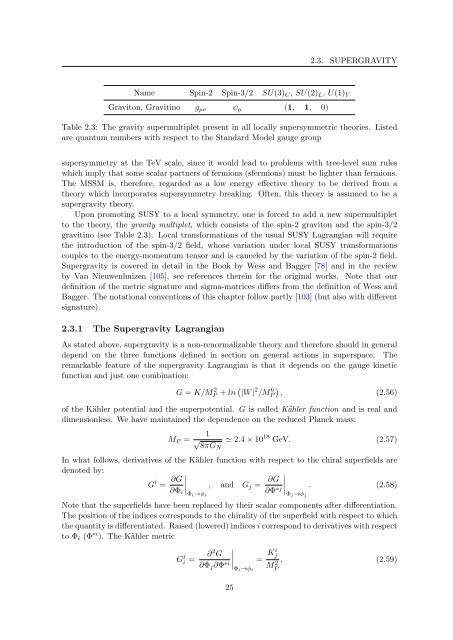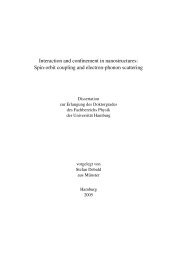Gravitinos and hidden Supersymmetry at the LHC - Universität ...
Gravitinos and hidden Supersymmetry at the LHC - Universität ...
Gravitinos and hidden Supersymmetry at the LHC - Universität ...
Create successful ePaper yourself
Turn your PDF publications into a flip-book with our unique Google optimized e-Paper software.
2.3. SUPERGRAVITY<br />
Name Spin-2 Spin-3/2 SU(3) C , SU(2) L , U(1) Y<br />
Graviton, Gravitino g µν ψ µ (1, 1, 0)<br />
Table 2.3: The gravity supermultiplet present in all locally supersymmetric <strong>the</strong>ories. Listed<br />
are quantum numbers with respect to <strong>the</strong> St<strong>and</strong>ard Model gauge group<br />
supersymmetry <strong>at</strong> <strong>the</strong> TeV scale, since it would lead to problems with tree-level sum rules<br />
which imply th<strong>at</strong> some scalar partners of fermions (sfermions) must be lighter than fermions.<br />
The MSSM is, <strong>the</strong>refore, regarded as a low energy effective <strong>the</strong>ory to be derived from a<br />
<strong>the</strong>ory which incorpor<strong>at</strong>es supersymmetry breaking. Often, this <strong>the</strong>ory is assumed to be a<br />
supergravity <strong>the</strong>ory.<br />
Upon promoting SUSY to a local symmetry, one is forced to add a new supermultiplet<br />
to <strong>the</strong> <strong>the</strong>ory, <strong>the</strong> gravity multiplet, which consists of <strong>the</strong> spin-2 graviton <strong>and</strong> <strong>the</strong> spin-3/2<br />
gravitino (see Table 2.3). Local transform<strong>at</strong>ions of <strong>the</strong> usual SUSY Lagrangian will require<br />
<strong>the</strong> introduction of <strong>the</strong> spin-3/2 field, whose vari<strong>at</strong>ion under local SUSY transform<strong>at</strong>ions<br />
couples to <strong>the</strong> energy-momentum tensor <strong>and</strong> is canceled by <strong>the</strong> vari<strong>at</strong>ion of <strong>the</strong> spin-2 field.<br />
Supergravity is covered in detail in <strong>the</strong> Book by Wess <strong>and</strong> Bagger [78] <strong>and</strong> in <strong>the</strong> review<br />
by Van Nieuwenhuizen [105], see references <strong>the</strong>rein for <strong>the</strong> original works. Note th<strong>at</strong> our<br />
definition of <strong>the</strong> metric sign<strong>at</strong>ure <strong>and</strong> sigma-m<strong>at</strong>rices differs from <strong>the</strong> definition of Wess <strong>and</strong><br />
Bagger. The not<strong>at</strong>ional conventions of this chapter follow partly [103] (but also with different<br />
sign<strong>at</strong>ure).<br />
2.3.1 The Supergravity Lagrangian<br />
As st<strong>at</strong>ed above, supergravity is a non-renormalizable <strong>the</strong>ory <strong>and</strong> <strong>the</strong>refore should in general<br />
depend on <strong>the</strong> three functions defined in section on general actions in superspace. The<br />
remarkable fe<strong>at</strong>ure of <strong>the</strong> supergravity Lagrangian is th<strong>at</strong> it depends on <strong>the</strong> gauge kinetic<br />
function <strong>and</strong> just one combin<strong>at</strong>ion:<br />
G = K/M 2 P + ln ( |W | 2 /M 6 P<br />
)<br />
, (2.56)<br />
of <strong>the</strong> Kähler potential <strong>and</strong> <strong>the</strong> superpotential. G is called Kähler function <strong>and</strong> is real <strong>and</strong><br />
dimensionless. We have maintained <strong>the</strong> dependence on <strong>the</strong> reduced Planck mass:<br />
M P =<br />
1<br />
√ 8πGN<br />
≃ 2.4 × 10 18 GeV. (2.57)<br />
In wh<strong>at</strong> follows, deriv<strong>at</strong>ives of <strong>the</strong> Kähler function with respect to <strong>the</strong> chiral superfields are<br />
denoted by:<br />
G i = ∂G ∣ ∣∣∣Φi<br />
, <strong>and</strong> G j = ∂G ∣ ∣∣∣Φj<br />
∂Φ i →φ i<br />
∂Φ ∗j . (2.58)<br />
→φ j<br />
Note th<strong>at</strong> <strong>the</strong> superfields have been replaced by <strong>the</strong>ir scalar components after differenti<strong>at</strong>ion.<br />
The position of <strong>the</strong> indices corresponds to <strong>the</strong> chirality of <strong>the</strong> superfield with respect to which<br />
<strong>the</strong> quantity is differenti<strong>at</strong>ed. Raised (lowered) indices i correspond to deriv<strong>at</strong>ives with respect<br />
to Φ i (Φ ∗i ). The Kähler metric<br />
G j i =<br />
∣ ∂2 G ∣∣∣Φi<br />
∂Φ j ∂Φ ∗i = Ki j<br />
→φ i<br />
MP<br />
2 , (2.59)<br />
25

















